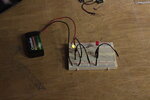automaton_be
Newbie level 2

Someone at the hackerspace I regularly visit, built this 1-bit memory circuit, and drew this schematic of it:

The idea is, that on set/reset, one or the other led comes on and stays on as long as the circuit is powered.
I've been trying to get this circuit to work, but to no avail. When I assemble the components on a breadbord, both leds illuminate dimly, and setting/resetting only momentarily makes one or the other brighter.
At this point, I'm trying to figure out whether the circuit design makes sense, before I start looking for broken components or an error on the breadboard.
So, if someone could just check this diagram for errors, that'd be awesome.

The idea is, that on set/reset, one or the other led comes on and stays on as long as the circuit is powered.
I've been trying to get this circuit to work, but to no avail. When I assemble the components on a breadbord, both leds illuminate dimly, and setting/resetting only momentarily makes one or the other brighter.
At this point, I'm trying to figure out whether the circuit design makes sense, before I start looking for broken components or an error on the breadboard.
So, if someone could just check this diagram for errors, that'd be awesome.




